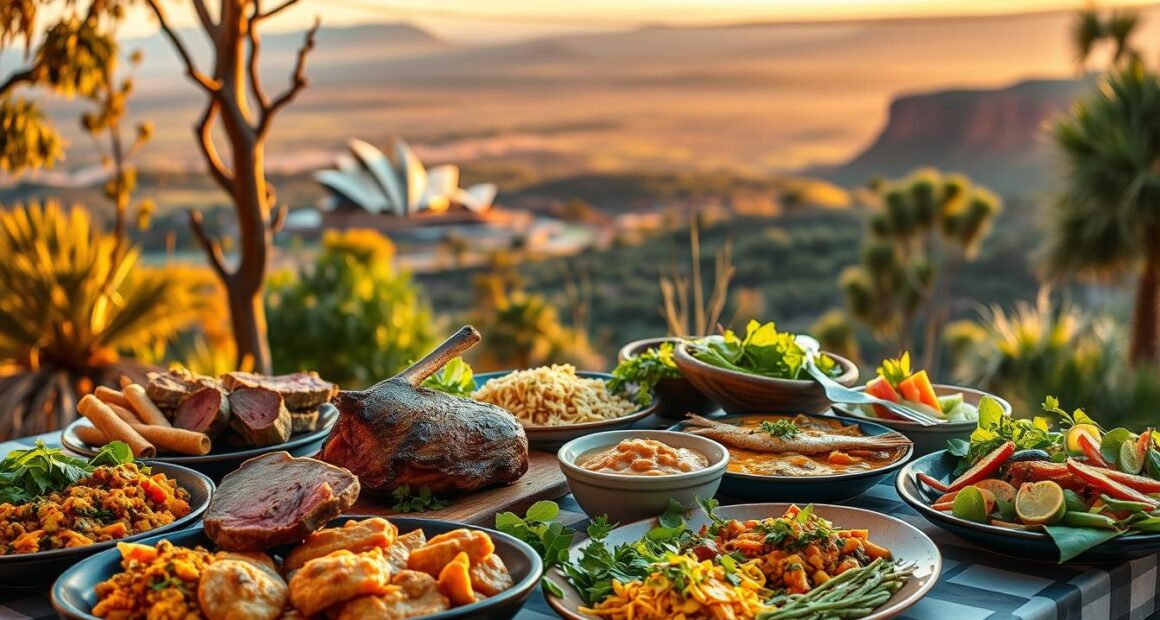Imagine standing on the sun-drenched beaches of Australia, the scent of salty sea spray mingling with the aroma of sizzling barbecues and freshly baked pastries. The vibrant colors of native bushland contrast beautifully with bustling urban streets lined with cafés, each serving a delightful array of dishes that tell stories of their heritage. Australian cuisine isn’t merely food; it is a melting pot of cultures that reflects the land’s rich history and diverse communities. In every bite, you can taste the essence of the bush tucker that Indigenous Australians have cherished for over 60,000 years, alongside the modern flavors brought by waves of migration. Whether it’s a classic meat pie, an iconic pavlova, or the simple pleasure of vegemite on toast, every dish invites you to embark on a culinary journey that celebrates the heart of Australian food. So, let’s delve into the exquisite world of Australian cuisine, where every meal is a delicious adventure waiting to be discovered.
Key Takeaways
- Australian cuisine is a blend of various cultural influences, creating unique flavors.
- Traditional dishes such as meat pies and pavlova are central to Australian food culture.
- Vegemite is a staple found in almost every Australian household.
- Indigenous ingredients are increasingly recognized and integrated into modern Australian dishes.
- The emphasis on fresh and local ingredients helps define the essence of Australian cooking.
What is Australian Cuisine?
Australian cuisine represents a vibrant tapestry woven from a multitude of cultural influences. It evolved from the early days of British settlement, when rations were limited but essential, including items like meat, flour, sugar, and tea. Over time, the introduction of various culinary traditions has transformed the landscape of food in Australia, reflecting its rich history and multicultural society.
A Melting Pot of Cultures
The influence of diverse communities shapes australian cuisine. The arrival of Chinese immigrants during the Gold Rush of 1851 brought dishes such as Yum Cha and dim sims, which are now beloved staples. Post-war migration from Europe and the Mediterranean saw large communities of Greeks, Italians, Turks, and Lebanese significantly contribute to the food scene. As a result, the culinary traditions in Australia are incredibly diverse, drawing from over 200 nationalities.
Traditional Indigenous Ingredients
Indigenous australian cuisine offers a wealth of unique ingredients that are increasingly embraced by modern cooks. Ingredients like kangaroo, emu, and native fruits not only provide distinct flavors but also highlight the connection to the land and its history. Renowned chef Rene Redzepi’s pop-up restaurant in Sydney is a notable example of how these ingredients can shine in the culinary spotlight.

Iconic Australian Dishes You Must Try
Australia offers a delicious array of traditional australian dishes that embody its vibrant culture and diverse flavors. When visiting, you simply can’t miss out on these iconic australian foods that have become symbols of the country’s culinary heritage. Each dish tells a story, inviting you to savor the unique tastes and experiences Australia has to offer.
Vegemite on Toast
Vegemite is a savory spread that dominates Australian breakfast tables. This dark, thick paste, made from brewers yeast extract, has a bold flavor that many describe as an acquired taste. Over 90% of Australians have tried Vegemite at least once, making it a staple in countless households. Spread on warm toast with a pat of butter, it offers a distinctive start to the day.
Meat Pies and Sausage Rolls
Meat pies and sausage rolls serve as quintessential snacks found in bakeries and corner shops across Australia. With approximately 4 million meat pies sold each week, this delight encapsulates the essence of comfort food. These hand-held pastries are typically filled with minced meat and gravy, served hot for a satisfying treat. The sausage roll, with its flaky pastry surrounding savory sausage meat, quickly becomes a favorite among casual diners.
Pavlova for Dessert
For those with a sweet tooth, Pavlova stands out among famous australian sweets. Touted as Australia’s national dessert, this meringue-based treat is renowned for its light and crispy exterior with a soft, marshmallow-like center. Each year, over 14 million pavlovas are consumed, often topped with whipped cream and an assortment of fruits. This delightful dessert sums up the sweet side of Australian cuisine beautifully.
![]()
Fresh and Local: The Key to Australian Cooking
Australian cooking reflects a strong commitment to fresh, local ingredients. The vibrant landscapes across the nation yield a bountiful selection of seasonal australian produce, which forms the cornerstone of many dishes. The emphasis on utilizing these ingredients not only enhances flavor but also supports local economies and sustainable practices.
Emphasis on Seasonal Ingredients
Seasonal australian produce plays a crucial role in creating delicious meals. Markets buzz with life, offering an array of fruits and vegetables that inspire creativity in the kitchen. By incorporating seasonal ingredients into your recipes, you can showcase the rich diversity of australian food. This approach allows for meals that vary throughout the year, highlighting what is freshest at any given time.
Farm-to-Table Philosophy
The australian farm-to-table movement strengthens the connection between growers and consumers. This philosophy thrives on the idea that food tastes better when it comes directly from local farms. By sourcing ingredients locally, chefs can prepare meals that reflect their region’s unique flavors and traditions. The taste of freshly harvested produce significantly enhances the dining experience, promoting a strong sense of community among diners and local food producers.
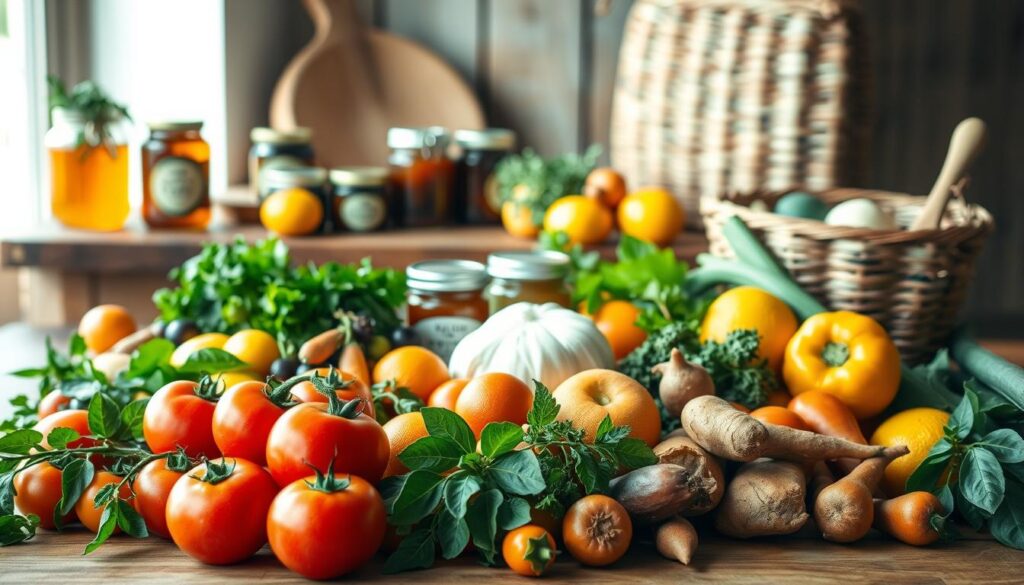
| Ingredient | Season | Usage |
|---|---|---|
| Barramundi | Spring & Summer | Grilled, in burgers, or as a fillet |
| Kangaroo Meat | Year-round | Roasted or grilled, in stews |
| Wattleseed | Spring | Used in baking and lattes |
| Quandong | Summer | Jam, sauces, and desserts |
| Emu Meat | Year-round | Roasted, served in stews |
Incorporating fresh produce not only elevates your culinary creations but also honors australia’s deep-rooted traditions of utilizing local ingredients. By embracing both seasonal australian produce and the farm-to-table philosophy, you contribute to a sustainable future for australian food culture.
How to Cook a Classic Aussie Barbecue
The Australian barbecue is more than just a meal; it represents a social celebration filled with great food, family, and friends. Understanding the essence of australian grilling techniques is vital for crafting the perfect outdoor feast. With a variety of high-quality australian meats to choose from, mastering these grilling skills will elevate your gathering to the next level.
Essential Grilling Techniques
To achieve the best results from your australian barbecue, a few essential grilling techniques should be on your radar. You can choose between direct grilling for quick cooking or indirect cooking for larger cuts of meat. Getting familiar with each method allows for variety and experimentation with your favorite australian meats.
- Direct Grilling: Ideal for smaller cuts like sausages and chicken, this method involves cooking over high heat.
- Indirect Cooking: Best for larger cuts such as roasts, this technique involves cooking with indirect heat for even doneness.
- Temperature Control: Use a meat thermometer to ensure meats are grilled to the perfect internal temperature.
- Resting: Allowing grilled meats to rest post-cooking helps retain juiciness and enhances flavor.
Popular Meats and Marinades
When it comes to australian meats, there is no shortage of choices. Australians are known to enjoy various meats, with steak, sausages, and chicken taking the lead. For a flavorful barbecue experience, using marinades can enhance these meats remarkably. Most Australians prefer marinades like chimichurri and pesto to amplify the dish’s richness, as about 50% of barbecuers incorporate sauces into their preparations.
| Meat Type | Popularity (%) | Marinade Options |
|---|---|---|
| Steak | 85 | Chimichurri, Garlic & Herb |
| Chicken | 70 | Pesto, Lemon & Thyme |
| Sausages | 90 | BBQ Sauce, Smoky Maple |
| Shrimp | Varies | Cajun, Lemon Zest |
As you prepare for your next barbecue, keep in mind the cultural significance of this outdoor event. Australians host around 4 million barbecues annually, making grilling a beloved pastime. Embrace the excitement, and enjoy the rich flavors of australian meats right from your backyard!

Unique Ingredients in Australian Cuisine
Australia’s culinary landscape is enriched by its diverse range of unique australian ingredients. Among these, kangaroo meat stands out as a nutritious and sustainable choice. This lean protein is becoming increasingly popular, aligning with contemporary diets that emphasize health and environmental consciousness. In addition to kangaroo meat, bush tucker encompasses a variety of native plants and traditional foods that reflect the rich heritage of Australia’s Indigenous culture. Understanding these ingredients is vital in appreciating the depth of Australian cuisine.
Kangaroo Meat: A Lean Option
Kangaroo meat has risen in popularity due to its lean quality and distinct flavor. It contains significantly less fat than most traditional meats, offering an excellent option for those seeking healthier dietary choices. Over the past decade, consumption of kangaroo meat has increased by 20%, highlighting a growing acceptance of unique australian ingredients in everyday meals. As chefs focus on local sourcing, kangaroo meat finds its way into various dishes across restaurants and households alike.
Bush Tucker and Native Plants
Bush tucker refers to the traditional foods used by Indigenous Australians, many of which are gaining recognition in modern culinary practices. Approximately 60% of Australian chefs are incorporating bush tucker ingredients into their menus, showcasing native herbs, fruits, and seeds that contribute rich flavors and nutritional benefits. The Australian food market has seen a 15% increase in the use of these native ingredients over the last five years, reflecting consumer demand for dishes that celebrate sustainability and cultural significance. Emphasizing such unique australian ingredients not only honors Indigenous heritage but also enhances Australia’s diverse food identity.
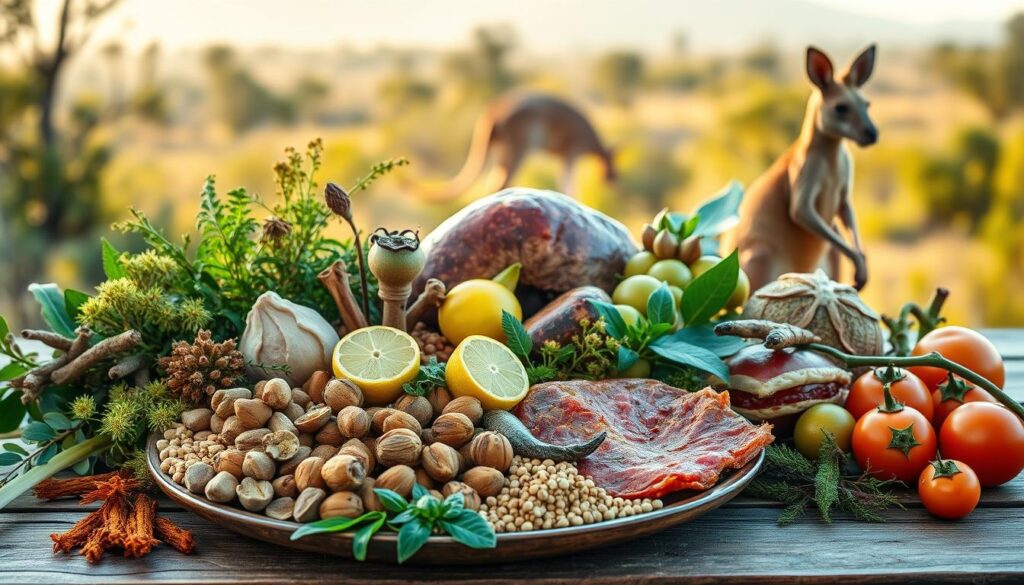
Popular Australian Beverages
Australia boasts a rich beverage culture that complements its diverse cuisine. Among the standout drinks, you’ll find flat white coffee, a beloved espresso-based beverage that has charmed coffee enthusiasts around the globe. The craft of preparing a perfect flat white involves silky, steamed milk that envelops the strong espresso flavor, making it an ideal choice for any time of day.
Flat White: The Coffee Culture
The origins of flat white coffee trace back to Australia, where it emerged in the 1980s. Its growing popularity has led to cafes worldwide incorporating this delightful drink into their menus. The balance of strong coffee and creamy texture has made it a favorite for many Australian beverage lovers. Grab a flat white during your morning routine, and you’ll experience the country’s coffee culture firsthand.

Australian Wines Worth Exploring
Australia’s wine regions produce exceptional australian wines, recognized globally for their quality and diversity. Known for varieties like Shiraz and Chardonnay, these wines reflect the unique terroir of different regions. Exploring local wineries, such as Barossa Valley and Margaret River, allows you to taste some of the country’s finest selections. Consider organizing a tasting tour or trying out a few bottles at home to dive deeper into the world of Australian wines.
| Wine Region | Notable Varieties | Price Range (AUD) |
|---|---|---|
| Barossa Valley | Shiraz, Grenache | 20 – 50 |
| Margaret River | Chardonnay, Cabernet Sauvignon | 25 – 60 |
| Hunter Valley | Sémillon, Shiraz | 15 – 40 |
| Yarra Valley | Pinot Noir, Sparkling | 30 – 80 |
In Australia, both flat white coffee and australian wines symbolize the nation’s dedication to crafting delightful beverages. Whether you enjoy a rich cup of coffee or a glass of finely aged wine, exploring these drinks offers a glimpse into Australian culture and its culinary heritage.
The Role of Seafood in Australian Cuisine
Seafood is a cornerstone of Australian cuisine, reflecting the country’s rich coastal heritage and diverse ecosystem. The prominence of australian seafood contributes not only to the local culinary scene but also plays an important role in international markets, with one billion high-quality seafood meals provided globally each year. Iconic seafood dishes in Australia showcase the unique flavors and freshness that this land has to offer.
Iconic Dishes Featuring Fish and Shellfish
Australian cuisine features a variety of seafood dishes that highlight the country’s best offerings. Barramundi, a favorite among locals and visitors alike, is often grilled or fried, allowing its natural flavors to shine through. Fresh prawns and mussels, such as those from Kinkawooka Shellfish, present delicious options that are low in fat and high in protein. These dishes celebrate the healthy benefits of seafood while enriching your dining experience with essential Omega-3 fatty acids.
Sustainable Fishing Practices
Sustainable fishing is crucial to maintaining the health of Australia’s marine environments. The seafood industry emphasizes ethical harvesting methods that respect both ecosystems and local communities. For instance, Indigenous Australians have practiced sustainable fishing for thousands of years, showcasing a deep-rooted respect for the ocean. Initiatives like “Great Australian Seafood, Easy As” encourage local consumption and educate the public about the importance of sustainable fishing practices in preserving marine life for future generations.

Australian Cuisine in Major Cities
Australia’s major cities boast vibrant culinary scenes that reflect the nation’s diversity and dedication to high-quality ingredients. You can find a variety of city-specific australian food when exploring urban areas. Both Sydney and Melbourne offer unique dining experiences that showcase the best of their local cultures.
Sydney: A Culinary Hotspot
Sydney restaurants provide a stunning reflection of the city’s multicultural population. You can indulge in offerings from Italian trattorias to Asian-fusion cafes, ensuring that there’s something for everyone. Iconic dishes like poached barramundi or a classic meat pie are just a few examples of what you might find across this bustling city’s dining landscape. Alongside local favorites, you will discover innovative takes on traditional recipes that highlight the creativity of Sydney’s chefs.
Melbourne: The Coffee Capital
If you’re passionate about coffee, Melbourne coffee culture is unmatched. The city’s boutique cafes pride themselves on serving expertly crafted brews, highlighting local roasters and unique blends. You can savor a classic flat white while enjoying the aromatic ambiance of your favorite café. The coffee scene here goes beyond just a cup; it’s a way of life, and many cafes incorporate elements of art, showcasing local talent alongside their delicious products.

Celebrating Food Festivals in Australia
Food enthusiasts find joy in exploring the vibrant scene of australian food festivals. These events spotlight local producers, talented chefs, and the diverse cuisine Australia has to offer. Among the most renowned festivals, the Taste of Sydney stands out as a premier event that captivates visitors with culinary experiences and interactive chef encounters.
Taste of Sydney Festival
The Taste of Sydney Festival provides a unique opportunity to sample dishes crafted by the city’s best chefs. This festival immerses you in the local food culture, featuring signature dishes from acclaimed restaurants and the chance to participate in cooking classes and demonstrations. With a focus on fresh, seasonal ingredients, the event not only satisfies your palate but also fosters a deeper appreciation for the culinary arts in the region.
Barossa Vintage Festival
The Barossa Vintage Festival showcases the rich culinary and vinicultural heritage of the Barossa Valley. Celebrating local produce, this festival brings together food lovers and wine aficionados for a joyous experience. Visitors can enjoy a variety of activities, from vineyard tours to tastings, all while promoting community engagement and sustainable agricultural practices.

Influences on Modern Australian Cuisine
Modern Australian cuisine reflects a vibrant tapestry of culinary influences, merging traditional practices with contemporary interpretations. This evolution results in innovative dishes that capture the essence of Australia while celebrating its multicultural heritage.
Asian and European Influences
Since World War II, Australia’s multicultural characteristics have beautifully shaped its modern gastronomic landscape. European culinary techniques meld seamlessly with Asian flavors, creating a unique style noted for its complexity. Chefs like Phillip Searle and Cheong Liew were pioneers during the early 1980s, showcasing how diverse culinary influences can harmonize to produce mouthwatering dishes. This blend allows for endless creativity, ensuring diners experience a global culinary journey within Australia.
The Rise of Fusion Cuisine
Australian fusion cuisine has taken center stage, emphasizing fresh, local produce and health-conscious options. The integration of indigenous ingredients like emu, wallaby, and bush tucker introduces distinctive flavors that distinguish modern Australian cuisine from other culinary traditions. Major cities such as Sydney and Melbourne host an array of restaurants specializing in this innovative approach, showcasing top chefs who are driving this evolution. The Opera House in Sydney stands as a premier destination for those eager to enjoy premium Australian food, reflecting the country’s commitment to culinary excellence.

Dietary Trends and Adaptations
In Australia, there has been a noticeable shift towards healthier eating habits among consumers. Over 70% of Australians express interest in incorporating bush tucker ingredients into their meals. This interest reflects a growing understanding of the benefits of embracing local and native produce, aligning with australian dietary trends that prioritize nutrition. As more people seek to improve their well-being, the focus on balanced diets featuring fruits, vegetables, and whole foods takes center stage.
Healthy Eating in Australia
The push for healthy eating resonates well within Australian culture. Approximately 60% of chefs prioritize sustainable and locally-sourced ingredients, which has led to a flourishing food scene that emphasizes nutrition and flavor. As a result, many dining establishments now offer menus filled with wholesome options that appeal to health-conscious patrons. Seafood consumption remains high, with Australians enjoying an average of 25 kg of seafood per person annually, reflecting a preference for quality, nutritious protein sources.
Vegan and Vegetarian Options
The rise of vegan australian cuisine has made a significant impact on dining across the country. Approximately 6% of consumers identify as fully plant-based, with others opting for flexitarian diets that allow for occasional meat consumption. This trend has led to a 25% increase in restaurants featuring bush tucker-inspired dishes in urban areas over the past five years. The creative menus found in these establishments highlight innovative ways to enjoy plant-based meals while promoting sustainable eating habits.
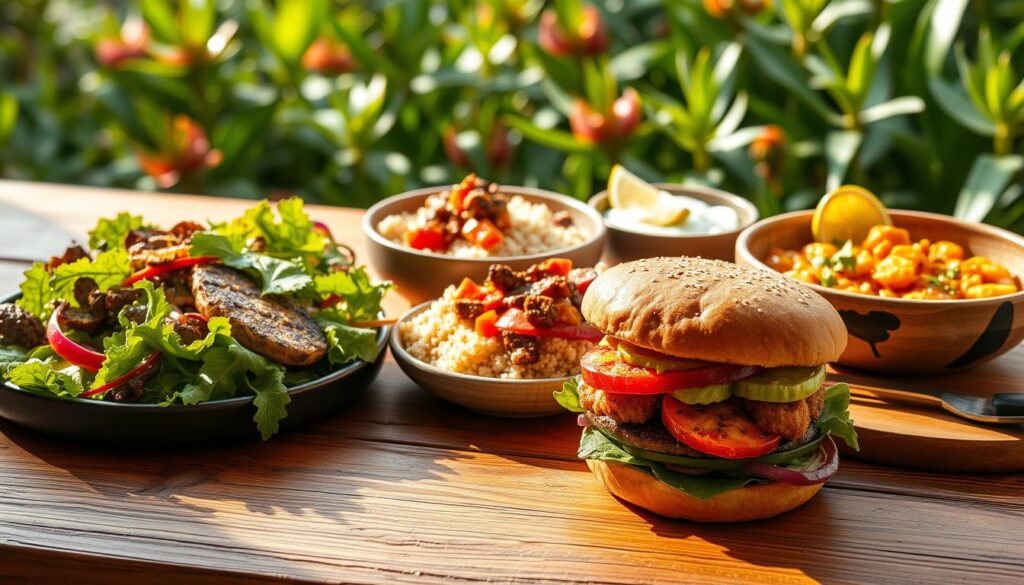
Australian Cuisine and Global Reach
Australian cuisine is making waves far beyond its borders, with an exciting journey of culinary exploration drawing international attention. The vibrant and diverse food culture reflects the country’s multicultural heritage, showcasing a variety of cuisines that captivate global diners. The global australian cuisine experience has seen increasing visibility, and the popularity of australian food is particularly evident in places like the United States.
Exporting Aussie Food Culture
The recent rise of australian food culture emphasizes unique flavors and innovative cooking methods. Critics from notable publications have traveled across Australia to explore this evolving culinary landscape. Notable findings indicate a diverse selection of dishes from national parks where one can find Thai cuisine to trendy tacos in cities like Adelaide. Such experiences highlight the adaptability and creativity of Australian chefs, allowing them to incorporate global culinary trends into their offerings.
Popularity in the United States
In the United States, the enthusiasm for australian food continues to grow. Many restaurants are embracing the eclectic mix of Australian dishes, influenced by the multicultural nature of the cuisine. The insights gained from culinary tours have helped American patrons connect with Australian flavors more intimately. The immense popularity of australian food, including well-known items like meat pies and fresh seafood, reflects an appetite for authentic and diverse dining experiences.
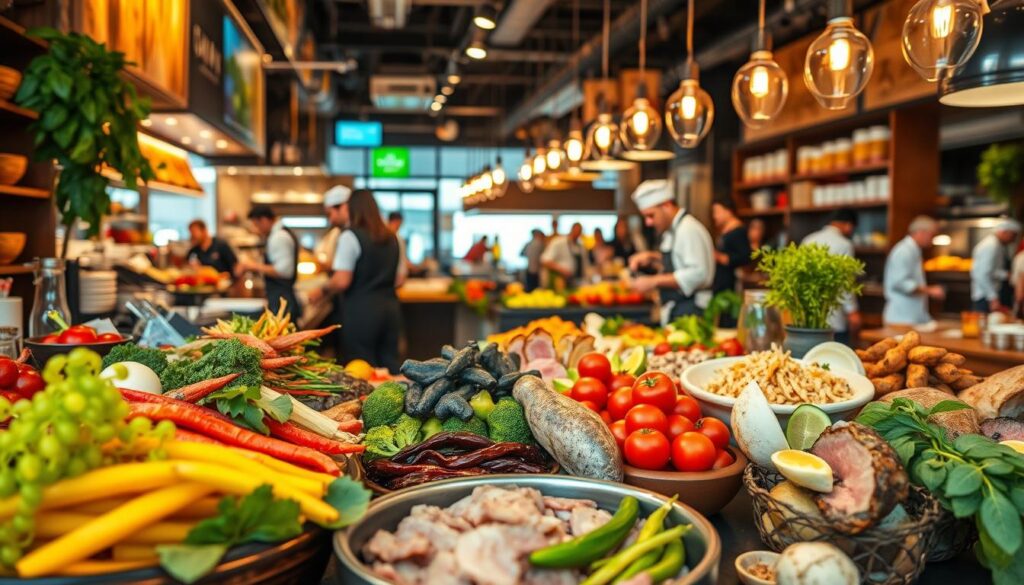
Cooking Australian Dishes at Home
Embarking on a journey of cooking Australian food at home can be a delightful experience for anyone. Mastering some easy recipes not only brings the flavors of Australia to your kitchen but also enhances your culinary confidence. With an average star rating of 4.4 out of 5 for various australian recipes, you can trust that these simple dishes are sure to impress family and friends.
Easy Recipes for Beginners
Starting with australian recipes can be a breeze. Here are some tried-and-true favorites to bring a taste of Australia to your plate:
- Chicken Drumsticks: Rated 4.5 out of 5 based on 306 reviews, these juicy drumsticks offer a perfect weeknight meal.
- Sausage Rolls: Enjoy a total preparation time of 1 hour and 30 minutes for 48 rolls, making it a great party snack.
- Bangers and Mash Pie: This classic recipe takes 1 hour and 20 minutes to prepare and serves 4 people, delivering comfort in each bite.
- Savoury Mince: This recipe yields enough for three batches, serving four people each, and takes only 50 minutes to prepare.
- Lamb Rissoles: Cooking time is 55 minutes for 20 rissoles, making it a satisfying meal option.
Tips for Sourcing Ingredients
To effectively recreate these classic dishes, sourcing australian ingredients is essential. Start by visiting local farmers’ markets or specialty grocery stores that offer authentic Australian products. Key ingredients like kangaroo meat, native herbs, and specialty cheeses can provide an authentic touch to your dishes. Explore online retailers that specialize in Australian imports to find difficult-to-source items. A combination of fresh local produce and authentic Australian ingredients will elevate your cooking experience.

Keep in mind that approximately 45% of the dishes analyzed have ratings above 4.5 stars, showcasing the quality and popularity of these recipes. Experimenting with new ingredients and flavors will help you discover exciting variations as you embark on your culinary journey. Happy cooking!
Final Thoughts on Embracing Australian Cuisine
As you delve into the rich tapestry of Australian cuisine, remember that it reflects a vibrant mix of cultures and flavors. From traditional Indigenous ingredients like bush tucker to the influences of immigrant populations, the spectrum of tastes is vast. By embracing Australian cuisine, you’re not just tasting food; you’re participating in a cultural journey that celebrates diversity and local traditions.
Encouraging Exploration of Flavors
Your journey into Australian flavor exploration can begin with the humble meat pie or a fresh barramundi dish. Take time to explore local markets or food festivals that showcase the country’s culinary artistry. Engaging with these elements will open your palate to exciting combinations and unique preparations, urging you to discover the stories behind each ingredient and dish.
Creating Your Own Aussie-Inspired Dishes
Don’t hesitate to experiment in your own kitchen and engage in cooking inspired dishes that reflect Australian culinary trends. From incorporating kangaroo meat into hearty stews to recreating a classic chicken Parmigiana, your creations can be personalized to suit your taste buds. Explore the farm-to-table philosophy, and let local, fresh ingredients guide your cooking. By doing so, you not only enhance your skills but also join in the celebration of Australian cuisine.
